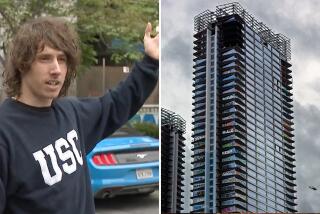Judge awards graffiti artists $6.7 million after their New York works were destroyed
Reporting from New York — A judge awarded $6.7 million Monday to graffiti artists who sued after dozens of spray-paintings were destroyed on the walls of dilapidated New York warehouse buildings torn down to make room for high-rise luxury residences.
U.S. District Judge Frederic Block in Brooklyn said 45 of the 49 paintings were recognized works of art “wrongfully and willfully destroyed” by a remorseless landlord.
Twenty-one aerosol artists had sued the owner of a Long Island City site known as 5Pointz under the Visual Rights Act, a 1990 federal law that protects artists’ rights even if someone else owns the physical artwork. Their graffiti was painted over in 2013, and the buildings were torn down a year later.
Before they vanished, the graffiti artworks became a tourist attraction, drawing thousands of spectators daily and forming a backdrop to the 2013 movie “Now You See Me,” and a site for an Usher tour, the judge noted.
All the while, the crime-ridden neighborhood gradually improved and it became the “world’s largest collection of quality outdoor aerosol art,” though a system set up by the artists meant some paintings were temporary while others were given permanent status, Block wrote.
The ruling followed a three-week trial in November, when Block said the “respectful, articulate and credible” artists testified about “striking technical and artistic mastery and vision worthy of display in prominent museums if not on the walls of 5Pointz.”
He noted one artist came from London, another from rural West Virginia, while others were products of prestigious art schools. Some were self-taught.
He said he was impressed with the breadth of the artists’ works and how many works “spoke to the social issues of our times.”
Jerry Wolkoff, who owned the buildings, had conceded he allowed the spray-paint artists to use the buildings as a canvas for decades but said they always knew they would be torn down someday. His lawyer, David Ebert, did not immediately respond to a message seeking comment.
The artists had once hoped to buy the properties, before their value soared to over $200 million.
Block said he hoped the award would give teeth to a federal law that should have kept Wolkoff from demolishing them for at least 10 months, when he had all his permits.
Artists then could have easily rescued some paintings from siding, plywood or sheet-rock before the rollers, spray machines and buckets of white paint arrived.
“Wolkoff has been singularly unrepentant. He was given multiple opportunities to admit the whitewashing was a mistake, show remorse, or suggest he would do things differently if he had another chance,” Block said.
“Wolkoff could care less. As he callously testified,” the judge said. “The sloppy, half-hearted nature of the whitewashing left the works easily visible under thin layers of cheap, white paint, reminding the plaintiffs on a daily basis what had happened. The mutilated works were visible by millions of people on the passing 7 train.”
More to Read
Sign up for Essential California
The most important California stories and recommendations in your inbox every morning.
You may occasionally receive promotional content from the Los Angeles Times.










